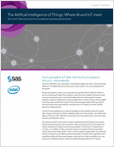 |
As you’re reading this, your organization may already be gathering massive volumes of useful data from IoT-enabled devices and sensors at its outer reaches. If so, you’re already off to a strong start.
But the real question is what is your organization doing with all that IoT data? For starters, if you’re not analyzing the data, it has virtually no value. Even then, analysis is still only a means to an end, pointing the way to a set of meaningful actions for solving specific business problems, using the insights that come from analysis. Who or what is acting on those insights? How frequently, and with what success? That’s where things get really interesting in light of the massive advances being notched in everything from IoT analytics to AI with machine learning and deep learning.
In short, it’s now possible to act on data immediately and automatically, wherever it’s generated, using a combination of artificial intelligence (AI) and IoT technologies – the artificial Intelligence of Things, or AIoT. With AIoT, devices learn from their specific use, or from each other, and then automate their actions
It’s a natural next step in the evolution of these complementary technologies, and one that holds tremendous business value implications. After all, AI systems thrive on the depth and volume of data that IoT systems are producing, whether on shop floors, in hospital rooms, on trucks, or in oil fields. IoT data, meanwhile, begs to be analyzed. And business leaders need to demonstrate better results – which come from greater insights, faster, more informed decision making, and more effective actions being taken in all parts of the organization. AIoT capabilities address all these needs together to give decision makers the ability to act more quickly and confidently, based on data and insights being generated from IoT assets.
Request Free! |